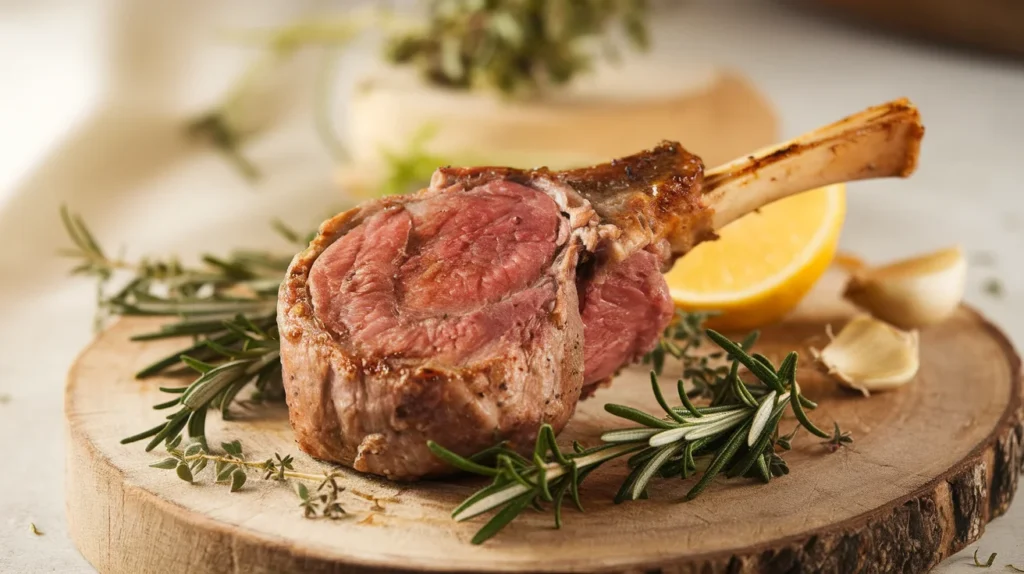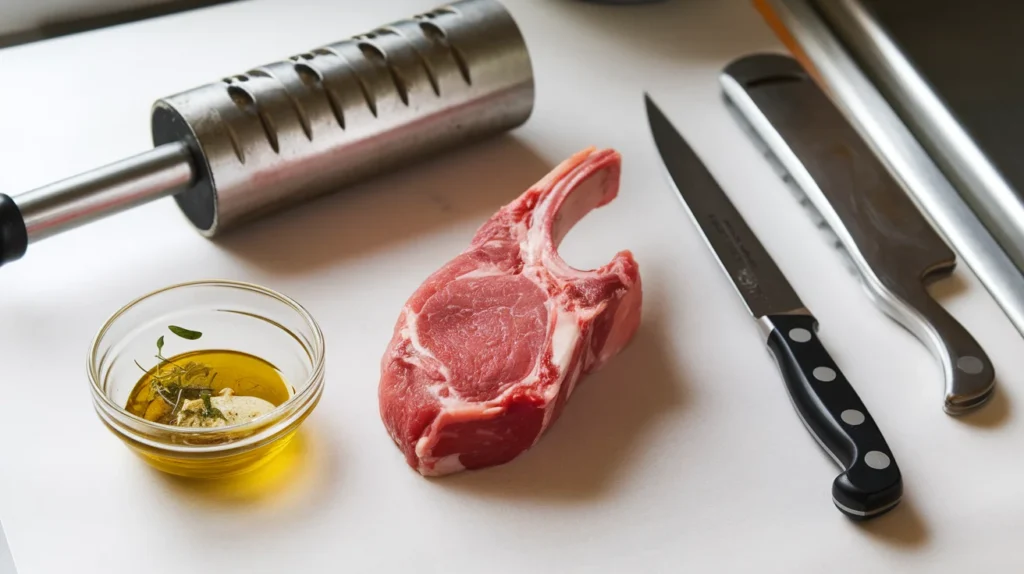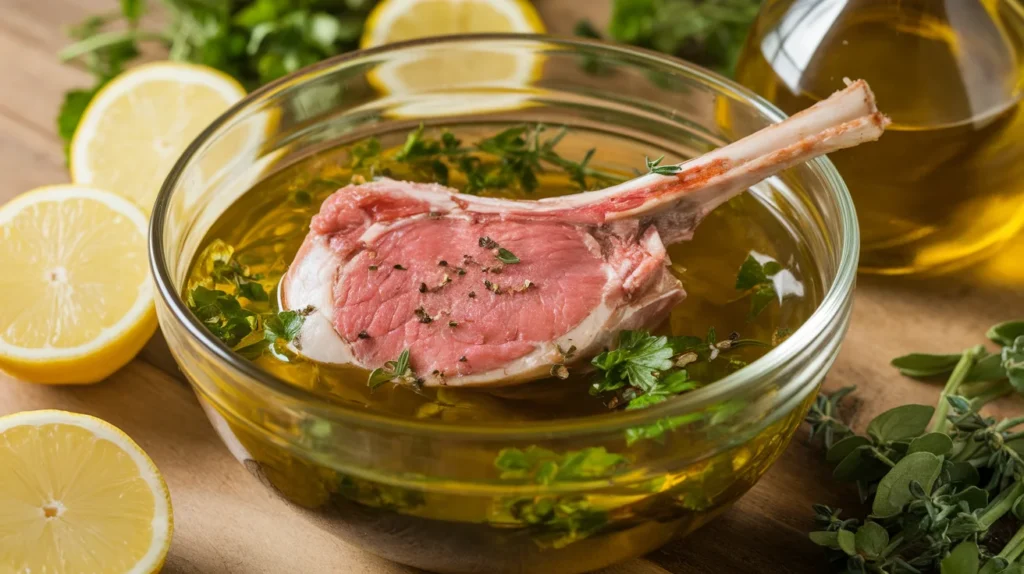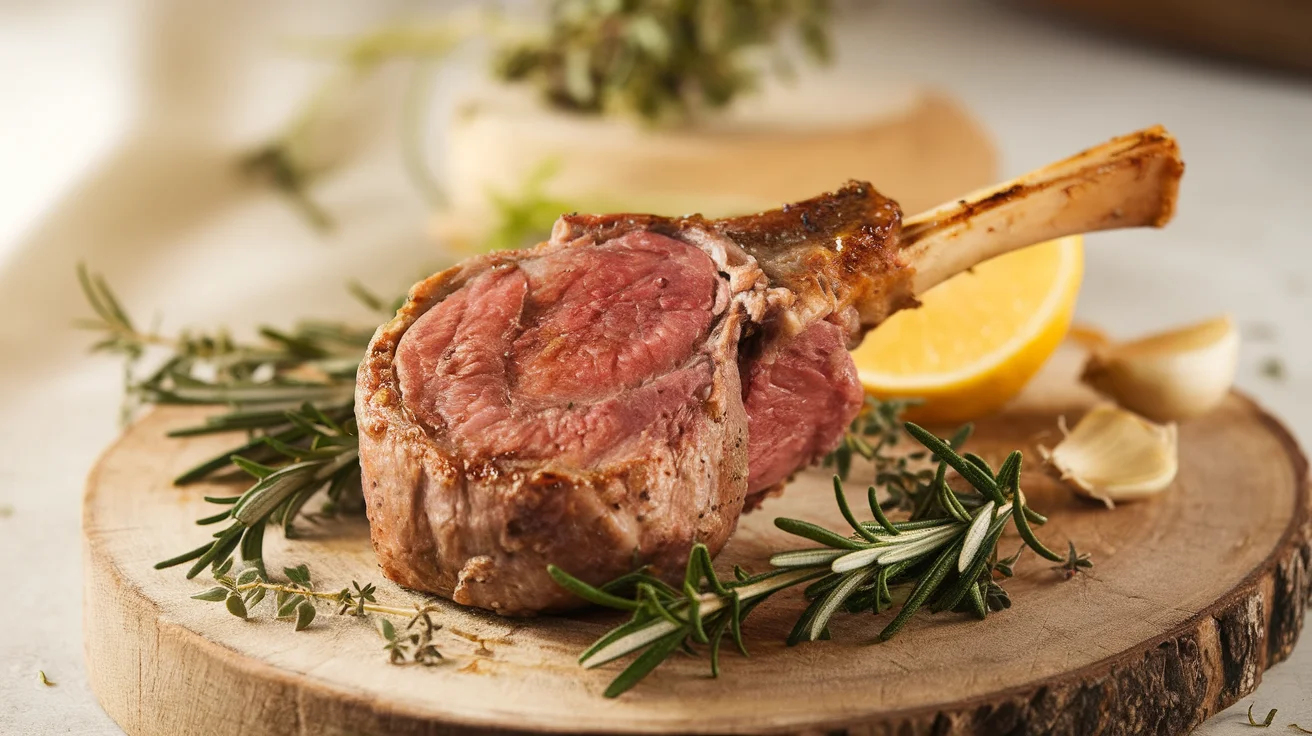Introduction

Lamb chops are a beloved delicacy, cherished for their rich, savory flavor and tender texture. Nevertheless, achieving perfectly tender lamb chops can be a challenge for many home cooks. For instance, the natural muscle structure of lamb can make some cuts tougher than others, which is why tenderizing is such an important step. Whether you’re planning to grill, pan-sear, or bake them, it’s crucial to take the time to prepare the chops properly. By doing so, you can ensure that every bite is as juicy and flavorful as possible.
Furthermore, tenderizing not only softens the meat but also allows marinades and seasonings to penetrate deeply, resulting in enhanced flavor. In contrast, skipping this step may lead to a tougher texture and uneven cooking, which can ultimately compromise the dining experience. Therefore, learning how to tenderize lamb chops is essential for anyone aiming to create a restaurant-quality dish at home.
Knowing how to tenderize lamb chops not only enhances their texture but also amplifies their natural flavors and makes them easier to cook. By employing proper techniques and using the right ingredients, you can elevate your lamb chops from ordinary to extraordinary. This guide will walk you through everything you need to know about tenderizing lamb chops, from understanding different methods to exploring the best marinades and cooking practices.
Understanding Lamb Cuts for Tenderizing Lamb Chops
To master the art of tenderizing lamb chops, it’s essential to start with a basic understanding of the different cuts and their unique characteristics. Not all lamb chops are created equal, and knowing the type of cut you’re working with will help you determine the most effective tenderizing method.
Types of Lamb Chops That Require Tenderizing
- Rib Chops
- Cut from the rib section, these are the most tender and often considered the most premium lamb chops. They require minimal tenderizing but can benefit from light marination to enhance flavor.
- Loin Chops
- These chops come from the loin section and are tender but slightly leaner than rib chops. A good marinade can add moisture and boost flavor.
- Shoulder Chops
- Shoulder chops are flavorful but tougher, as they come from a more worked part of the lamb. These benefit greatly from tenderizing techniques like marinating or slow cooking.
- Sirloin Chops
- Sirloin chops are a versatile cut that sits between tender and tough. Proper tenderizing can ensure they are juicy and flavorful.
Why Certain Cuts of Lamb Chops Need Tenderizing
Lamb cuts vary in muscle structure and fat content, which affect their tenderness:
- Worked Muscles: Shoulder and sirloin chops have more connective tissue, making them tougher and requiring additional tenderization.
- Fat Content: Fat acts as a natural tenderizer during cooking. Cuts with less marbling, like loin chops, may need external tenderizing to compensate.
Why Tenderizing Lamb Chops is Essential for Soft, Juicy Meat
Tenderizing lamb chops isn’t just about making them softer; on the contrary, it’s also about enhancing their overall eating experience. In addition, properly tenderized lamb chops cook more evenly, which means they retain their juiciness and avoid drying out during high-heat cooking methods like grilling or searing. Moreover, tenderized lamb absorbs marinades more effectively, allowing flavors to penetrate deeply into the meat. As a result, every bite is bursting with taste and perfectly balanced seasoning.
What’s more, tenderizing creates a melt-in-your-mouth texture that truly elevates any meal. Whether you’re hosting a dinner party or preparing a casual family meal, properly tenderized lamb chops can transform your dish into a memorable experience. Thus, it’s clear that tenderizing is an essential step in preparing lamb chops, not only for better texture but also for a more flavorful and satisfying result. Let’s delve deeper into why this step is so important and how it can enhance your cooking.
1. Enhanced Flavor Infusion
Tenderizing allows marinades, spices, and seasonings to penetrate deeply into the meat. The process breaks down muscle fibers, creating openings where flavors can seep in. This ensures every bite bursts with a balanced blend of natural lamb taste and your chosen seasonings.
- Example: When using acidic marinades with lemon juice or vinegar, tenderizing helps distribute the tangy flavors uniformly throughout the chop.
2. Improved Cooking Results
Tenderizing ensures even cooking by softening tougher muscle fibers. Tougher cuts like shoulder chops benefit the most, as tenderizing helps them cook at a consistent rate with more tender portions like rib or loin chops.
- Without Tenderizing: The exterior of the chop may cook faster, leaving the inside undercooked or tough.
- With Tenderizing: Heat penetrates the meat more uniformly, producing a juicy, evenly cooked chop.
3. Better Texture
A tough lamb chop can ruin even the most carefully planned meal. Tenderizing transforms chewy, fibrous meat into soft, succulent cuts that are easy to chew and enjoy. This is particularly crucial when preparing lamb for guests or special occasions.
- Tip: Marinating with dairy-based ingredients like yogurt or buttermilk can significantly soften the texture without over-tenderizing.
4. Increased Moisture Retention
Tenderizing helps lamb chops retain moisture during cooking, especially when using dry-heat methods like grilling or pan-searing. By breaking down muscle fibers and connective tissues, tenderization reduces the likelihood of the meat drying out.
- Methods for Moisture Retention: Using marinades with oils, salt brines, or yogurt ensures that moisture is locked into the meat during the cooking process.
5. Maximizing Tougher Cuts
Shoulder and sirloin chops are naturally tougher due to their location on the lamb and the amount of work these muscles perform. Tenderizing these cuts helps you achieve restaurant-quality results at home without needing to rely solely on premium cuts like rib chops.
- Budget Tip: Shoulder chops are typically more affordable, and with the right tenderizing techniques, they can be transformed into a gourmet centerpiece.
6. Adapting to Various Cooking Methods
Certain cooking methods like grilling or pan-searing require tenderizing to prevent the meat from becoming dry or chewy. Tenderized lamb chops respond better to high-heat cooking, maintaining their juiciness and tenderness.
- For Grilling: Tenderizing prevents overcooking while ensuring a crisp, caramelized crust.
- For Braising: Pre-tenderizing chops allows the meat to soak up rich sauces during slow cooking.
Summary of Benefits
- Tenderized lamb chops are flavorful, moist, and evenly cooked.
- They ensure a pleasant eating experience, even when using tougher cuts.
- Tenderizing methods help make lamb more versatile for various recipes and cuisines.
Must-Have Tools for Tenderizing Lamb Chops

Tenderizing lamb chops can be done effectively with the right tools and techniques. Whether you’re relying on simple kitchen utensils or specialized equipment, having the correct tools ensures your lamb is perfectly tenderized without compromising its texture or flavor.
1. Meat Mallets
A meat mallet is a classic tool for mechanical tenderizing. It’s especially useful for tougher cuts like shoulder or sirloin chops. The mallet features two sides: one flat and one textured.
- How to Use:
- Place the lamb chop between two sheets of plastic wrap or parchment paper to prevent splattering.
- Use the textured side to gently pound the meat, focusing on thicker areas.
- Benefits:
- Breaks down muscle fibers.
- Creates an even thickness, promoting uniform cooking.
2. Meat Tenderizer Powder
Meat tenderizer powder is an enzyme-based solution often derived from papain (from papaya) or bromelain (from pineapple). These enzymes break down proteins in the meat, making it softer.
- How to Use:
- Sprinkle the powder evenly over both sides of the lamb chops.
- Let it sit for 30 minutes to an hour before cooking.
- Caution: Avoid overusing, as it can result in overly mushy meat.
3. Marinade Bags
Specially designed marinade bags with seals are excellent for soaking lamb chops in tenderizing liquids like acidic marinades or yogurt-based mixes. These bags lock in moisture and flavor.
- How to Use:
- Place the lamb chops in the bag.
- Add your preferred marinade.
- Refrigerate for the recommended time (4–24 hours depending on the marinade).
4. Sharp Knife for Scoring
Scoring the meat is a simple yet effective tenderizing technique. It involves making shallow cuts across the surface of the lamb chop.
- How to Use:
- Use a sharp knife to make diagonal cuts about 1/4-inch deep on both sides of the chop.
- Avoid cutting too deeply to maintain the chop’s structure.
- Benefits:
- Helps marinades penetrate deeper.
- Reduces cooking time by increasing surface area.
5. Bladed Meat Tenderizers
A bladed meat tenderizer is a handheld tool with multiple sharp blades designed to pierce the meat. This is particularly useful for tougher lamb cuts.
- How to Use:
- Place the tenderizer over the chop and press down to puncture the meat.
- Repeat across the entire surface.
- Benefits:
- Increases marinade absorption.
- Softens connective tissues without flattening the meat.
6. Blender or Food Processor (for Marinades)
A food processor is invaluable for creating smooth marinades with tenderizing ingredients like garlic, herbs, and yogurt.
- How to Use:
- Blend ingredients into a consistent mixture.
- Coat the lamb chops evenly and marinate for several hours.
7. Zester or Grater
A zester or fine grater is a tool for incorporating tenderizing agents like lemon zest, ginger, or garlic into marinades.
- Benefits: These ingredients release natural enzymes and acids that help break down muscle fibers in lamb.
Tips for Choosing the Right Tools
- Consider the Cut: Use meat mallets or bladed tenderizers for tougher cuts like shoulder chops, while rib chops may only require a marinade.
- Avoid Over-Tenderizing: Mechanical tools like mallets or bladed tenderizers should be used sparingly to prevent the meat from becoming overly soft.
- Combine Methods: Pair mechanical tenderizing with a marinade or brining process for optimal results.
Natural Methods to Soften and Tenderize Lamb Chops

When it comes to tenderizing lamb chops, natural methods are among the most effective and accessible options. They rely on everyday ingredients and simple techniques that you can apply right in your kitchen without the need for specialized equipment. These methods are particularly appealing because they enhance the natural flavor of the meat while breaking down tough fibers.
1. Acidic Ingredients
Acids are a powerful tenderizing agent as they break down proteins in the meat, making it softer and juicier. Common acidic ingredients include lemon juice, vinegar, and wine.
- Lemon Juice or Lime Juice:
- The citric acid gently tenderizes lamb chops and adds a bright, tangy flavor.
- Mix lemon juice with olive oil, garlic, and herbs for a quick marinade.
- Vinegar:
- Use apple cider vinegar, white vinegar, or balsamic vinegar for a deeper, tangy profile.
- Combine with honey or sugar to balance acidity and enhance tenderness.
- Wine:
- Red or white wine can tenderize and add complexity to the flavor.
- Red wine pairs well with robust seasonings like rosemary, while white wine works beautifully with lighter marinades.
2. Dairy-Based Marinades
Dairy products like yogurt, buttermilk, and kefir are traditional tenderizers, especially in Mediterranean and Middle Eastern cuisines. These ingredients contain lactic acid, which breaks down muscle fibers in the lamb.
- Yogurt Marinade:
- Yogurt tenderizes lamb chops while adding a creamy texture and subtle tang.
- Combine yogurt with garlic, cumin, paprika, and a splash of olive oil for a flavorful Mediterranean-style marinade.
- Buttermilk:
- Buttermilk works similarly to yogurt, tenderizing the lamb and keeping it moist.
- Use a spiced buttermilk marinade with chili flakes and ground coriander for an Indian-inspired flavor.
3. Enzymatic Fruits
Certain fruits like pineapple, papaya, and kiwi contain natural enzymes (bromelain, papain, and actinidin, respectively) that break down proteins, making them excellent tenderizers.
- Pineapple:
- Fresh pineapple juice can quickly tenderize lamb chops, but it must be used sparingly to avoid over-softening.
- Marinate for no longer than 1–2 hours.
- Papaya:
- Blend papaya into a paste and rub it onto the lamb chops.
- Papaya works well for tougher cuts like shoulder chops.
- Kiwi:
- Mashed kiwi can tenderize lamb in as little as 15 minutes.
- Use it in small quantities mixed with other marinade ingredients for balanced flavor.
4. Mechanical Tenderizing
While this involves a tool, the simplicity of pounding or scoring qualifies as a natural technique.
- Pounding:
- Gently flatten lamb chops with a meat mallet, ensuring the thickness is even for uniform cooking.
- Scoring:
- Make shallow cuts in a crisscross pattern to help marinades penetrate deeper and break down connective tissue.
5. Salt as a Tenderizing Agent
Salt is a versatile tenderizer that works by breaking down the proteins in meat while enhancing its flavor.
- Dry Brining:
- Coat lamb chops in coarse salt and let them sit in the refrigerator for 30 minutes to a few hours.
- Rinse off excess salt before cooking.
- Saltwater Brine:
- Dissolve salt in water and submerge the lamb chops for several hours.
- This method locks in moisture and creates a tender texture.
6. Herbal and Spice Blends
Certain spices and herbs can act as mild tenderizers while enhancing the flavor of lamb chops.
- Garlic and Ginger:
- Both contain enzymes that help tenderize lamb.
- Create a paste of garlic and ginger and rub it onto the chops before cooking.
- Cumin and Coriander:
- These spices, when ground, can tenderize lamb chops and infuse them with earthy, aromatic flavors.
7. Resting the Meat
Resting lamb chops after applying tenderizing techniques allows the enzymes or acids to fully penetrate the meat. This step is critical for achieving a consistent texture.
- How to Rest:
- Let the lamb sit in the marinade or brine for the recommended time.
- Rest the meat for a few minutes after cooking to allow the juices to redistribute.
Pro Tips for Natural Tenderizing
- Timing Matters: Avoid over-marinating or over-tenderizing, as this can make the meat mushy.
- Combine Techniques: Pair acids with dairy or use salt alongside mechanical tenderizing for tougher cuts.
- Test Before Cooking: Check the texture of the lamb by gently pressing it to ensure it’s not overly tenderized.
FAQs About Tenderizing Lamb Chops
1. What is the best way to tenderize lamb chops?
The best way to tenderize lamb chops depends on the cut and your preference. Marinades with acidic ingredients like lemon juice or yogurt work well for most cuts. For tougher cuts like shoulder chops, a combination of mechanical tenderizing and marinating is highly effective.
2. How long should I marinate lamb chops?
Marination time depends on the cut:
- Tender cuts (rib and loin chops): 2–4 hours.
- Tougher cuts (shoulder or sirloin chops): 8–24 hours.
Avoid over-marinating, as the acid can make the meat mushy.
3. Can I tenderize lamb chops without a mallet?
Yes, you can tenderize lamb chops without a mallet. Use natural methods like marinades, dry brining with salt, or scoring the meat. Even a simple yogurt-based marinade can break down the fibers effectively.
4. Should I rinse off a marinade before cooking lamb chops?
It depends on the marinade. If the marinade contains high levels of sugar or sticky components, you might want to pat the chops dry to prevent burning during cooking. Otherwise, light excess marinade can stay on the chops for additional flavor.
5. Can lamb chops be over-tenderized?
Yes, lamb chops can become overly tenderized if marinated for too long, especially with highly acidic marinades. This can result in a mushy texture. Follow the recommended marination times for the best results.
6. What’s the easiest tenderizing method for beginners?
For beginners, a simple marinade with olive oil, lemon juice, garlic, and herbs is the easiest and most foolproof method. It requires minimal effort and delivers tender, flavorful chops every time.
Conclusion
Tenderizing lamb chops is a skill that can transform your cooking, ensuring every meal is a memorable experience. From understanding the anatomy of different cuts to applying natural tenderizing techniques and crafting flavorful marinades, you now have the tools to make your lamb chops tender, juicy, and delicious.
By choosing the right method—whether it’s marinating with yogurt, using a meat mallet, or employing acidic ingredients—you can tailor the process to fit your taste and cooking style. Remember to allow adequate resting time after tenderizing and to pair your methods with the proper cooking techniques for perfect results.
With practice and these expert tips, you’ll soon master the art of tenderizing lamb chops, impressing friends and family with restaurant-quality dishes in the comfort of your home. So, roll up your sleeves, grab your favorite marinade recipe, and enjoy the journey to lamb chop perfection!

